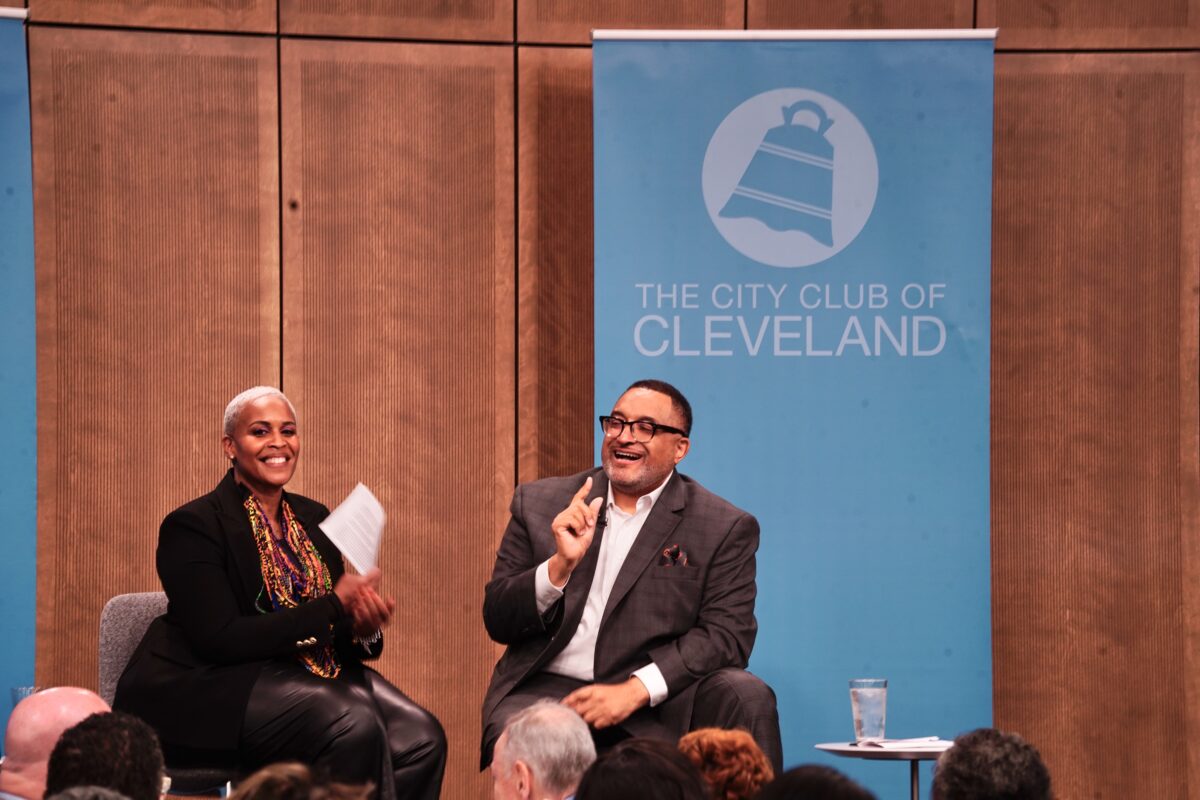By Vince Robinson
Recently, there was a City Club of Cleveland event called The Changing Landscape of Arts and Culture in Northeast Ohio which featured a question and answer session conducted by Rhonda Brown, Chief Strategist for Arts, Culture and the Creative Economy with Jeremy Johnson, President and CEO of the Assembly for the Arts. The Assembly is a non-profit arts advocacy and research organization that provides support for artists, non-profits and creative businesses in Cuyahoga County.
According to an economic impact study by Americans for the Arts, Cuyahoga County’s nonprofit arts and culture industry generated more than $533 million in economic activity in 2022, a fact mentioned by Johnson. “Even in the aftermath of the pandemic, we were a half billion dollar industry, just in Cuyahoga County, just in non-profits. I’m not even talking about those other legs, individual artists, creative businesses. When we put all of that together, we are a powerhouse and we must continue to be that powerhouse.”
He spoke of the importance of the current levy that supports the arts through a tax on cigarettes which will expire without support from voters to extend it. “We are unique in the country. We have a special levy that only supports the arts community, the non-profit arts community. It’s twenty years old. It has delivered 4,000 grants to a quarter-billion dollars and we can’t let that go away.”
Johnson came back to Cleveland after working in Newark, New Jersey as Executive Director of Newark Arts. He became President and CEO for the Assembly for the Arts in 2021.
Said Johnson, “What I’ve learned in years of working in public/private sector is there’s gotta be collaboration. There’s got to be partnership. There has to be people that invest in that glue, knowing that our city leadership is working with the arts sector, know that our county leadership is working in partnership. Knowing that philanthropy is at the table. What excites me about Cleveland is all these partners are coming together.
Both Brown and Johnson spoke with clarity about the breadth of artists and genres in our community, not limiting their scope to visual artists but including the wide range that includes performance, literary, culinary, fashion, and many others.
Ironically, this state of the arts conversation was preceded by a State of the City address by Cleveland Mayor Justin Bibb a few weeks prior. In his speech, the mayor spent considerable time in his nearly hour-long comments detailing measures to address public safety, almost 20 minutes to be exact. Cleveland now has 52 cadets in its current police academy. It’s larger than the four previous iterations combined, although published reports indicate that 3 recruits have dropped out.
He mentioned ShotSpotter, a technology for gunshot detection. $10-million has been spent on that thanks to funds from the American Rescue Plan Act which saw a windfall of $512-million for city coffers due to the pandemic. Add to the public safety budget another $2.3 million for new dash cams, $26 million for public safety equipment, and $10 million for a Violence Prevention Endowment Fund. All of these go in to the pot of funds earmarked for the city’s public safety budget of $400 million, which is nearly 54% of the city’s total operating budget for 2024.
Last year, the Assembly for the Arts encouraged city leaders to consider appropriating $10 million dollars to support arts and culture in Cleveland. An appropriation was made after months of others pleading their cases for appropriations for various things. $3 million was earmarked for art and culture from the federally funded gift to Cleveland, amounting to .5% of the total ARPA amount.
Those dollars have been provided to the Assembly for the Arts for a grant program called the Transformative Art Fund, a project-based idea that will award $250K to $500K grants in artist/artist teams and institutional partners who’ll serve as fiscal agents to create in Cleveland neighborhoods in the coming year.
It is important to note that the City of Cleveland legally cannot provide direct support to artists in the way that it does public safety personnel. As a result, the Assembly for the Arts is serving as the custodian of the funds that will be given to the institutional partners to provide to the artists to carry out their projects.
These projects promise to have a transformative effect in many ways, as they speak to the ability of artists to address the needs of people and create modalities that foster healing, grief recovery, boost self-esteem, improve the environment and most critically, address racism as a public health crisis.
The real tragedy here is that in the minds of many people, politicians and the general public, public safety has been the primary concern at the expense of the power of art to be the answer to our insecurity about existence.
We are willing to accept tax dollars being spent on tracking gunshots and recording encounters with the police who are hired to protect us from each other and respond to the results of trauma and human dysfunction. This is seen as an alternative to the proactive approach of engaging human beings in the practice and process of creation and engagement in art as a means of self-love, empowerment and edification.
We live in a city in which only a few students get exposure to the arts and a majority go without the benefit of art and culture in their classrooms. Many of the these students end up in the pipeline to prisons where ironically, some find themselves saved by art.
The definition of insanity involves the idea of doing the same thing over and over but somehow expecting a different result. The current model of addressing the ills of our society is insanity. Only when the approach is changed will we see significant change. In the interim, racism will continue to be the public health crisis that goes largely unaddressed as we live in fear of each other and demand Cleveland hire more police officers.
Art is at the heart of possibilities to impact lives in a meaningful way. Only when this is understood and embraced by the people who make the decisions about how our tax dollars are spent can we realize those possibilities.
Now is the time.





